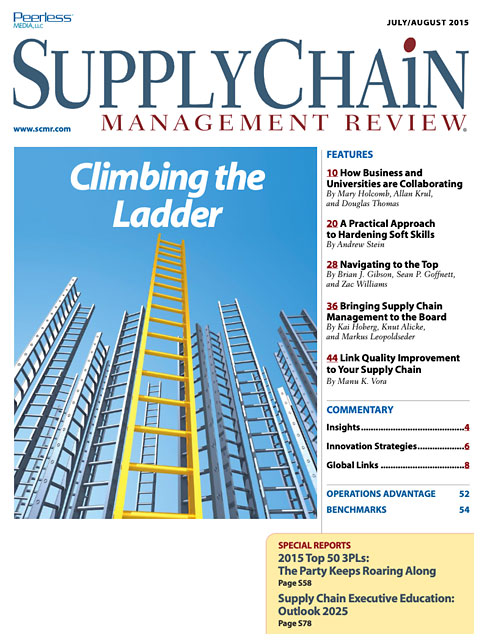Sorry, but your login has failed. Please recheck your login information and resubmit. If your subscription has expired, renew here.
July/August 2015
When it comes to career development, supply chain managers have to execute a bit of jiu jitsu. They’re charged with nding and developing the next generation of talent while simultaneously advancing their own careers in a eld that is often overlooked by senior management. The biggest challenge of all is getting their agenda in front of the Board at a time when supply chain operations are more critical than ever to an organization’s success, but still largely invisible compared to sales, marketing, and product development. Remember: It’s your career—and your supply chain. We hope this month’s issue will help you make the most of both. Browse this issue archive.Need Help? Contact customer service 847-559-7581 More options
As supply chain management becomes a more strategic function and senior supply chain professionals prepare to retire, there is an increasing need to develop strong leadership capabilities. In fact, past research conducted by APQC indicates that leadership is one of the top skills needed for a career in supply chain management. Recent human capital management research from APQC sheds light on which leadership skills are most important to develop and the development techniques used by organizations.
For its Leadership Deficit study, APQC surveyed 547 business professionals representing a variety of industries. Analysis of the survey responses shows that organizational leadership is evolving. Current business trends, including the rise of knowledge work, globalization, and the increase in Millennial workers, are leading organizations to take a more dynamic approach to leadership.
Organizations using a dynamic leadership style are non-hierarchical, meaning they have few layers of managers between the CEO and front-line employees. Employees have the authority to make decisions without having to secure approval from many levels of management. They are also rewarded for collaborating and sharing information and resources. These rewards can include positive feedback, public recognition, challenging work assignments, or compensation. Employees are not rewarded for competing individually against each other.
 |
This complete article is available to subscribers
only. Click on Log In Now at the top of this article for full access. Or, Start your PLUS+ subscription for instant access. |
SC
MR
Sorry, but your login has failed. Please recheck your login information and resubmit. If your subscription has expired, renew here.
July/August 2015
When it comes to career development, supply chain managers have to execute a bit of jiu jitsu. They’re charged with nding and developing the next generation of talent while simultaneously advancing their own careers… Browse this issue archive. Access your online digital edition. Download a PDF file of the July/August 2015 issue.
 |
Download Article PDF |
As supply chain management becomes a more strategic function and senior supply chain professionals prepare to retire, there is an increasing need to develop strong leadership capabilities. In fact, past research conducted by APQC indicates that leadership is one of the top skills needed for a career in supply chain management. Recent human capital management research from APQC sheds light on which leadership skills are most important to develop and the development techniques used by organizations.
For its Leadership Deficit study, APQC surveyed 547 business professionals representing a variety of industries. Analysis of the survey responses shows that organizational leadership is evolving. Current business trends, including the rise of knowledge work, globalization, and the increase in Millennial workers, are leading organizations to take a more dynamic approach to leadership.
Organizations using a dynamic leadership style are non-hierarchical, meaning they have few layers of managers between the CEO and front-line employees. Employees have the authority to make decisions without having to secure approval from many levels of management. They are also rewarded for collaborating and sharing information and resources. These rewards can include positive feedback, public recognition, challenging work assignments, or compensation. Employees are not rewarded for competing individually against each other.
 |
SUBSCRIBERS: Click here to download PDF of the full article. |
SC
MR

Latest Supply Chain News
- Tech investments bring revenue increases, survey finds
- Survey reveals strategies for addressing supply chain, logistics labor shortages
- Israel, Ukraine aid package to increase pressure on aerospace and defense supply chains
- How CPG brands can deliver on supplier diversity promises
- How S&OP provides the answer to in-demand products
- More News
Latest Podcast

 Explore
Explore
Topics
Latest Supply Chain News
- Tech investments bring revenue increases, survey finds
- Survey reveals strategies for addressing supply chain, logistics labor shortages
- Israel, Ukraine aid package to increase pressure on aerospace and defense supply chains
- How CPG brands can deliver on supplier diversity promises
- How S&OP provides the answer to in-demand products
- AI, virtual reality is bringing experiential learning into the modern age
- More latest news
Latest Resources

Subscribe

Supply Chain Management Review delivers the best industry content.

Editors’ Picks





